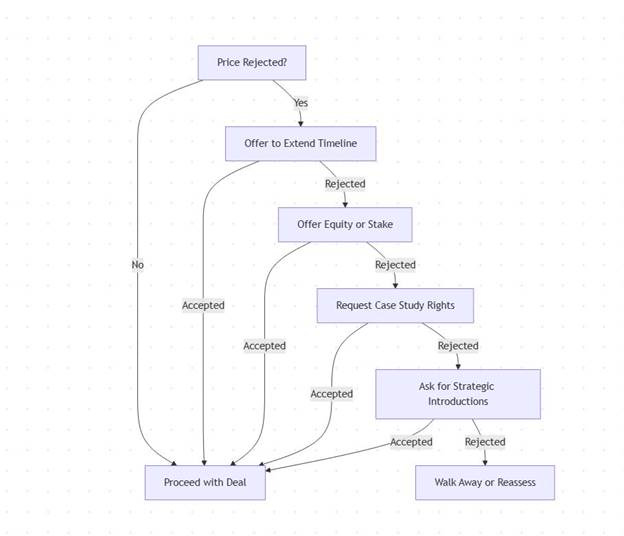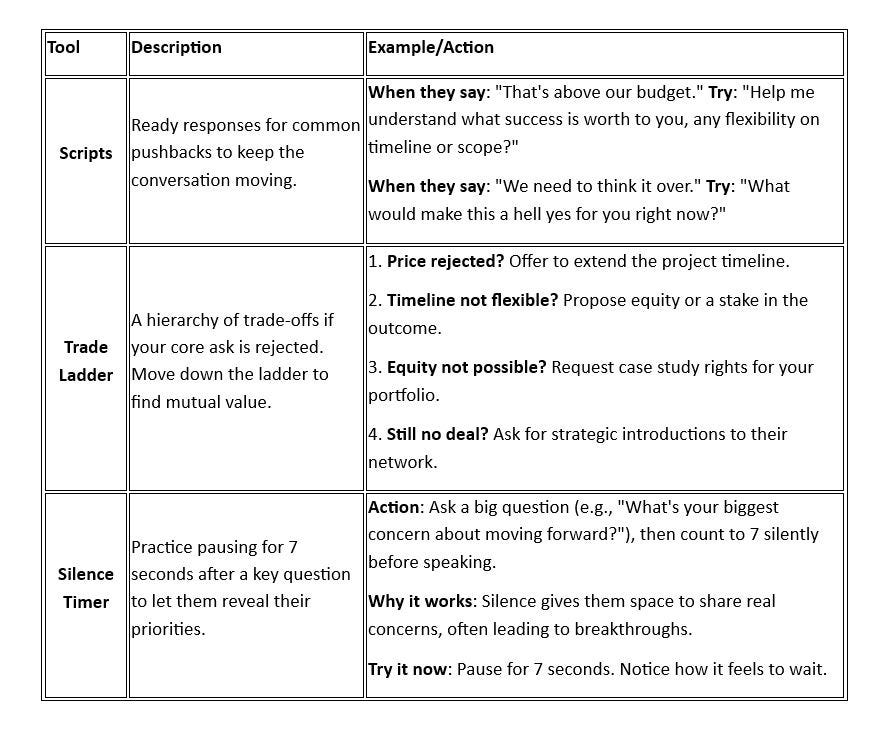How to Leave the Table with Your Soul and Your Strategy Intact
Negotiation Tactics for Win-Win Outcomes:
"To make a good salad is to be a brilliant diplomat, the problem is entirely the same in both cases. To know how much oil to mix in with one's vinegar." — Oscar Wilde
Let's Begin with a Lie:
"A good negotiation is when both sides walk away equally unhappy."
Cute. But no.
A good negotiation is when both sides walk away clear: on what they gained, what they gave up, and why it was worth it.
Unhappiness isn't the goal, alignment is.
But here's the real trick: most people don't negotiate for clarity. They negotiate to win.
Which is why they lose.
The $7.4 Billion Lesson: How Jobs and Iger Redefined Win-Win
2005, Steve Jobs and Disney CEO Bob Iger sat across from each other with $7.4 billion on the table.
The relationship was toxic. Jobs had walked away from Disney negotiations the year before, with Disney forming their own animation studio and Jobs actively seeking other partners. The stakes couldn't be higher, Disney's animation division was failing, and Pixar needed a distribution partner that wouldn't destroy their creative culture.
Traditional negotiation would have focused on price, terms, and control. Instead, Iger did something radical.
He asked Jobs to make two lists on a whiteboard: pros and cons of a Disney acquisition. Jobs' cons included "Disney's culture will destroy Pixar!" and "DISTRACTION WILL KILL PIXAR'S CREATIVITY."
But here's the genius move: Instead of defending Disney or dismissing Jobs' concerns, Iger said, "You're right. Now let's figure out how to make sure that doesn't happen."
The breakthrough came when they stopped negotiating a purchase and started designing a partnership. The final deal wasn't just about Disney buying Pixar, it included promises to keep Pixar's culture intact, maintain creative autonomy, and essentially let Pixar teach Disney how to make great animation again.
The result? Disney bought Pixar for $7.4 billion in 2006, Jobs became Disney's largest individual shareholder and a board member, and both companies thrived.
It proved to be "the smartest move of Iger's career, restoring his company" to animation leadership.
They both won because they negotiated the relationship, not just the transaction.
The Difference Between a Win and a Win-Win
In a win-lose negotiation, someone gets what they want, and someone smiles while quietly resenting you. This might be fine for buying a car. It's terrible for partnerships, business deals, creative work, or anything involving humans with memory and feelings.
In a win-win negotiation:
You both feel seen
You both feel smart
And you both walk away with something you didn't have before, not just money, but momentum
Tactics I Use (That Don't Feel Like Tactics)
1. Lead with Vision, Not Price
Money is the final act, not the opening scene.
When I negotiate, I don't start with my rates. I start with the outcome:
Instead of: "My retainer is $X per month." I say: "Here's the transformation I want us to create together. Let me show you what your customers will be saying about you in six months."
This reframes the whole conversation. You're not a cost. You're an investment.
2. Don't Mirror Power, Reframe It.
In rooms full of posturing (VCs, execs, the tech bros of it all), you will find power in not performing back. They expect you to match their aggression.
Instead, meet it with clarity. Calm. A pause that lets them wonder what you know that they don't.
When someone says: "That's way above our budget." Don't say: "Well, you get what you pay for." Try: "Help me understand what success is worth to you."
3. Know Your Yes, Know Your No
Before stepping into any negotiation, write down two things:
Your absolute yes (what success looks like)
Your absolute no (what I'll walk away from)
This will ground you. It keeps you from spiraling when the pressure turns up.
4. Use the "What Would Make This a Hell Yes?" Line
If someone's hesitant, ask:
"What would make this a hell yes for you?"
It turns the conversation into collaboration. And it surfaces what they really care about, which is rarely what they say at first.
Real example: A client said budget was the issue. When I asked the "hell yes" question, turns out they were terrified of looking stupid to their board. We restructured the proposal to include board presentation coaching. Budget suddenly wasn't a problem.
5. Never Compromise Your Core Ask , Trade Around It
If they can't budge on price, fine.
Then extend the timeline. Reduce scope. Or ask for something non-monetary, equity, referrals, spotlight.
Creative trades might include:
Lower fee for equity + case study rights (could pay off significantly if they grow)
Reduced scope for strategic introductions (networking value can exceed immediate payment)
Faster timeline for completion bonus (aligns incentives and motivates everyone)
Money is only one form of leverage. Creativity is another.
Negotiating as a Woman: The Invisible Tax
Let's not pretend the playing field is neutral.
Research shows women are more likely to be penalized for negotiating assertively, especially if we're perceived as "too confident." The challenge isn't just asking for what we want; it's asking without triggering the unconscious bias that labels us as "difficult."
Here's what I do:
Frame as Problem-Solving, Not Positioning:
"How can we structure this so it works for both of us?"
Not: "Here's what I require."
Use Collaborative Language:
"Let's explore options" vs. "Here's my demand"
"What if we tried..." vs. "You need to..."
Anchor Value with Evidence, Not Ego:
"Here's what this work generated for a similar company"
Not: "I'm worth this because I'm experienced"
The Reality: You'll still encounter people who think assertive women are aggressive. That's their problem, not your strategy problem.
Power doesn't have to be loud. It has to be clear.
The Most Underrated Skill in Negotiation? Listening.
Most people talk too much when they're nervous or when they're trying to prove worth. But the smartest negotiators I know ask great questions, then shut up.
Ask:
"What's your biggest concern about moving forward?"
"What would success look like to you in 12 months?"
"What's completely off-limits for you?"
Then let silence do its work.
Power listens. Ego performs.
Negotiation SWAT Kit
This table equips you with quick tools to negotiate smarter. Use these scripts, trade ladder, and silence timer to stay confident and collaborative in any deal.
How to Use:
Scripts: Memorize or adapt these to sound natural. Use them to reframe objections as opportunities.
Trade Ladder: Start at the top and work down to keep the deal alive without compromising your core ask.
Silence Timer: Practice in low-stakes settings to build confidence for high-pressure moments.
In Case You Forget Everything Else:
Don't just negotiate contracts. Negotiate conditions for success.
Don't just ask for what you want. Know why you want it.
Don't treat the other person as your opponent. Treat them as your future collaborator.
Remember: the person across the table wants to feel smart about saying yes to you.
The Bottom Line
A win-win isn't just an outcome. It's a feeling that something more is possible now than before you sat down.
And that's the kind of power that lasts.
Lights On is here to help you navigate the rooms where power is traded and walk out with more than just a handshake. If this helped you rethink how you negotiate, forward it to a friend who's selling themselves short.
Until next time, keep your lights on.






